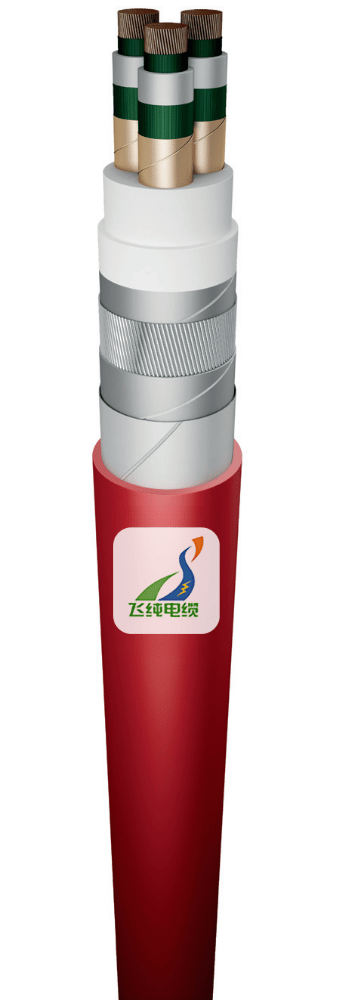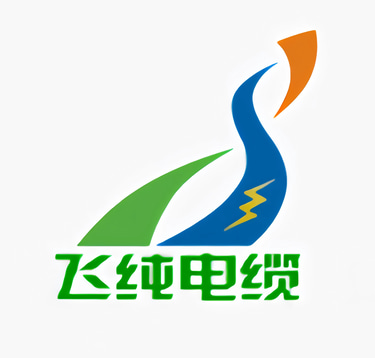Type YRUHKGXSekyn 3.6/6 kV Mining Power cables
High magnetic field special mining power cable, tinned copper wire shielding mesh, high flexible copper core,
cross-linked polyethylene insulation, polyvinyl chloride sheath, with seal
radial overall shielding, PVC sheath longitudinal seal flame retardant


These high-performance power cables are specially designed for use in underground mining environments.
They are engineered to handle high magnetic fields and are suitable for installations in both methane and non-methane areas of mines.
The cables are rated for a nominal voltage up to 6 kV and meet the standard ZN-TF 203:2006.
Cable Construction
Conductor:
Made of round, multi-stranded, compacted copper conductors (Class 2 as per EN 60228).
Screening:
Working Conductor Screen: A screen is applied directly on the working conductors using conductive tape or a polyethylene-based material.
Individual Conductor Screen: Each conductor is wrapped with a layer that combines a conductive tape and copper tape—or alternatively, conductive polyethylene with copper tape.
Overall Screen: An additional layer of copper tape is wrapped around the entire cable to provide overall shielding.
Insulation:
The cables use cross-linked polyethylene (XLPE) insulation (Type DIX 3) in compliance with PN-HD 620 S1:2002.
Core Arrangement:
The working conductors are twisted around a central core (which can be a copper wire or strand) to ensure mechanical stability.
Filler and Inner Sheath:
A filler layer made of non-vulcanized rubber or tire cord material is used to fill the space.
An inner sheath of PVC (type DMV 31, following PN-HD 620 S1:2002) covers the insulation.
Sealing:
Radial Sealing: Achieved using an Al/PVC tape that wraps around the cable.
Longitudinal Sealing: A tape that swells when exposed to water and moisture is applied along the cable’s length, ensuring a water-tight seal.
Outer Sheath:
The final layer is an outer PVC sheath (also DMV 31 type, with flame retardant properties) that provides mechanical protection and flame resistance.
Technical Characteristics
Insulation & Sheath Colors:
Insulation: Natural color.
Outer Sheath: Red.
Temperature Ratings:
Operating Temperature (Conductor): Up to +90 °C.
Minimum Ambient Temperature: –30 °C for permanently laid cables.
Installation Temperature: Minimum of –50 °C (for laying without pre-heating).
Short-Circuit Temperature: Can reach up to +2500 °C.
Mechanical and Electrical Tests:
Bending Radius: Minimum bending radius is 12 times the cable’s external diameter.
Test Voltage: The cable can withstand a test voltage of 15 kV AC (applied for 5 minutes at 50 Hz).
Flame Propagation: Complies with IEC 60332-1-2 and IEC 60332-3-24 standards.
Tensile Strength: Maximum tensile strength is defined as 50 times the total cross-sectional area of the working conductors.
Electrical Performance and Dimensions
Cable Sizes:
The cables are available in various sizes (for example, 3x25/25, 3x35/25, etc.) with detailed specifications provided for:Nominal cross-sectional area of the conductors.
Thicknesses of the insulation, inner sheath, and overall screen.
Approximate external diameter and weight per kilometer.
Maximum resistance of the conductor at 20 °C.
Electrical Parameters:
Tables include current carrying capacities (ampacity) at an ambient temperature of +25 °C.
Unit inductance and inductive reactance are specified, which are important for network design.
Installation and Derating Factors
Cable Bundling:
When multiple cables are installed one above the other on supports, the current carrying capacity must be derated using correction factors:
1 cable: factor of 1.00
2 cables: factor of 0.93
3 cables: factor of 0.90
6 cables: factor of 0.87
9 cables: factor of 0.86
Ambient Temperature Correction:
For ambient temperatures above +25 °C, further derating is applied:
30 °C: correction factor 0.96
35 °C: correction factor 0.92
40 °C: correction factor 0.88
45 °C: correction factor 0.83
50 °C: correction factor 0.78
55 °C: correction factor 0.73
Applications and Certifications
Intended Use:
Specifically designed for underground mining power distribution networks.
Suitable for environments where there is a risk of methane or coal dust explosions (classified under hazard classes “a”, “b”, and “c”).
Certifications:
Recognized by EMAG and WUG.
Meets RoHS standards.
Certified to operate with maximum temperatures of +90 °C and minimum of –5 °C.
Packaging:
Typically supplied in lengths of 500 or 1000 meters per drum, with custom lengths and packaging options available.

Frequently Asked Questions (FAQ)
Q: What is the nominal voltage rating of these cables?
A: They are rated for a nominal voltage of up to 6 kV.
Q: What is the primary application of these cables?
A: They are designed for underground mining power distribution systems in hazardous environments.
Q: Which industry standards do these cables comply with?
A: They conform to ZN-TF 203:2006 and meet requirements per EN 60228 and PN-HD 620 S1:2002.
Q: What conductor material is used in these cables?
A: The cables use round, multi-stranded, compacted copper conductors.
Q: What type of insulation is provided?
A: They feature cross-linked polyethylene (XLPE) insulation for enhanced thermal and electrical performance.
Q: How is individual conductor screening achieved?
A: Each conductor is wrapped with a conductive layer, either using a combination of conductive tape and copper or conductive polyethylene with copper tape.
Q: What is the purpose of the overall copper tape screen?
A: It provides additional electromagnetic shielding, which is crucial in high magnetic field environments like mining sites.
Q: How does the cable handle high magnetic fields?
A: The inclusion of a tinned copper wire shielding mesh helps reduce electromagnetic interference in high-field conditions.
Q: What are the operating temperature limits for the cable's conductor?
A: The conductor can operate continuously at temperatures up to +90 °C.
Q: How high can the conductor temperature rise during a short-circuit?
A: The cable can withstand short-circuit temperatures of up to +2500 °C.
Q: What are the minimum ambient and installation temperature ratings?
A: The minimum ambient temperature is –30 °C (permanently laid cables) and –50 °C during installation without pre-heating.
Q: How is water and moisture ingress prevented?
A: The cable uses dual sealing systems: a radial seal with an Al/PVC tape and a longitudinal seal via a swelling tape activated by moisture.
Q: What material is the outer sheath made of?
A: The outer sheath is made from flame-retardant PVC (type DMV 31).
Q: What are the color specifications for the insulation and outer sheath?
A: The insulation is natural colored, while the outer sheath is red.
Q: How is the cable designed to meet flame propagation standards?
A: It complies with IEC 60332-1-2 and IEC 60332-3-24, ensuring proper flame retardancy.
Q: How does the cable’s construction support flexibility and mechanical strength?
A: The flexible copper core, combined with robust insulation and sheath layers, ensures durability under mechanical stresses common in mining environments.
Q: What is the role of the filler material in the cable?
A: A non-vulcanized rubber or tire cord filler is used to maintain cable shape and provide additional mechanical support.
Q: How are the working conductors arranged within the cable?
A: They are twisted around a central core (which can be a copper strand or wire) to improve structural stability.
Q: What test voltage is applied during cable quality verification?
A: The cable is tested with a 15 kV AC voltage for 5 minutes at 50 Hz.
Q: How is the minimum bending radius determined?
A: The minimum bending radius is specified as 12 times the external diameter of the cable.
Q: What cable sizes are available?
A: They are available in various sizes (e.g., 3x25/25, 3x35/25, 3x50/25, etc.), each with specific conductor cross-sectional areas.
Q: How are electrical parameters like resistance and inductance provided?
A: Detailed tables list the nominal conductor resistance, unit inductance, and inductive reactance at 20 °C for each cable size.
Q: How do cable bundling and installation configurations affect current capacity?
A: When cables are installed in parallel (stacked on supports), correction factors (ranging from 1.00 to 0.86) must be applied to account for reduced cooling.
Q: How does ambient temperature influence current carrying capacity?
A: Derating factors are used for ambient temperatures above +25 °C, ensuring safe operation under various environmental conditions.
Q: What makes these cables suitable for explosive atmospheres in mining?
A: They are specifically designed and certified for use in methane and coal dust explosive environments (classified as hazard areas “a,” “b,” and “c”).
Q: Which certifications attest to the cable's suitability for mining applications?
A: Certifications from EMAG, WUG, and compliance with RoHS standards verify their safety and reliability.
Q: What is the significance of the tinned copper shielding mesh?
A: It enhances performance in high magnetic field conditions by effectively reducing electromagnetic interference.
Q: How does the cable maintain performance under chemical exposure?
A: The robust PVC outer sheath and effective sealing systems ensure resistance to moisture and chemicals found in mining environments.
Q: Can these cables handle heavy mechanical stresses on site?
A: Yes, their construction, including flexible conductors and robust insulation, is engineered to withstand mechanical stresses typical in mining operations.
Q: What type of flame retardancy does the outer sheath offer?
A: The flame-retardant PVC sheath meets international standards to reduce the risk of fire propagation.
Q: How are the cables packaged for delivery?
A: Standard packaging options include 500 or 1000 meters per drum, with custom lengths and packaging available upon request.
Q: What are the key electrical benefits of XLPE insulation in these cables?
A: XLPE insulation offers excellent thermal resistance, high dielectric strength, and long-term stability under harsh conditions.
Q: How is overall electromagnetic interference (EMI) managed in these cables?
A: Multiple screening layers, including individual and overall copper tape shields, work together to minimize EMI.
Q: What measures are taken to ensure the cable’s long-term reliability in mines?
A: Robust sealing, flame retardancy, mechanical reinforcement, and adherence to rigorous testing and certification standards all contribute to long-term reliability.Q: How do these cables contribute to operational safety in mining operations?
A: Their design minimizes electrical faults, short circuits, and fire risks while ensuring stable performance in challenging, high-hazard environments.






Type YRUHKGXSekyn 3.6/6 kV Mining Power Cable
A high-performance electrical solution engineered for the toughest underground mining environments. Designed for safe and reliable power distribution, this cable features: Robust Construction: Round, multi-stranded, compacted copper conductors with advanced tinned copper shielding provide excellent performance in high magnetic fields. Superior Insulation: High-quality XLPE insulation ensures excellent thermal resistance and dielectric strength. Enhanced Safety: A flame-retardant PVC outer sheath combined with dual water-resistant sealing systems (radial and longitudinal) protects against moisture, chemicals, and fire hazards. Industry-Certified: Complies with stringent standards (ZN-TF 203:2006, EN 60228, PN-HD 620 S1:2002) for use in hazardous mining areas, including methane and coal dust explosive environments. Ideal for underground mining and other demanding industrial applications, the Type YRUHKGXSekyn cable is engineered to deliver durability, flexibility, and safety while meeting the rigorous electrical requirements of modern mining operations.
6/30/20217 min read
